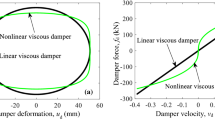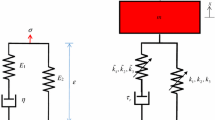Abstract
Viscoelastic dampers are now among some of the preferred energy dissipation devices used for passive seismic response control. To evaluate the performance of structures installed with viscoelastic dampers, different analytical models have been used to characterize their dynamic force deformation characteristics. The fractional derivative models have received favorable attention as they can capture the frequency dependence of the material stiffness and damping properties observed in the tests very well. However, accurate analytical procedures are needed to calculate the response of structures with such damper models. This paper presents a modal analysis approach, similar to that used for the analysis of linear systems, for solving the equations of motion with fractional derivative terms for arbitrary forcing functions such as those caused by earthquake induced ground motions. The uncoupled modal equations still have fractional derivatives, but can be solved by numerical or analytical procedures. Both numerical and analytical procedures are formulated. These procedures are then used to calculate the dynamic response of a multi-degree of freedom shear beam structure excited by ground motions. Numerical results demonstrating the response reducing effect of viscoelastic dampers are also presented.
Similar content being viewed by others
References
Bagley RL and Calico RA (1991) “Fractional Order State Equations for the Control of Viscoelastically Damped Structures,” Journal of Guidance, Control, and Dynamics, 14(2): 304–311.
Bagley RL and Torvik PJ (1983a) “Fractional Calculus — A Different Approach to the Analysis of Viscoelastically Damped Materials,” AIAA Journal, 21(5): 741–748.
Bagley RL and Torvik PJ (1983b) “A Theoretical Basis for the Application of Fractional Calculus to Viscoelasticity,” Journal of Rheology, 27(3): 201–210.
Bagley RL and Torvik PJ (1985) “Fractional Calculus in the Transient Analysis of Viscoelastically Damped Structures,” AIAA Journal, 23(6): 918–925.
Chang T (2002), “Seismic Response of Structures with Added Viscoelastic Dampers,” Ph.D. Dissertation, Virginia Tech, Blacksburg, VA 24061.
Escobedo-Torres J and Ricles JM (1998) “The Fractional Order Elastic-Viscoelastic Equations of Motion: Formulation and Solution Methods,” Journal of Intelligent Material Systems and Structures, 9: 489–502.
Koh CG and Kelly JM (1990) “Application of Fractional Derivatives to Seismic Analysis of Base-Isolated Models,” Earthquake Engineering and Structural Dynamics, 12: 229–241.
Miller KS and Ross B (1993), An Introduction to the Fractional Calculus and Fractional Differential Equations, John Wiley & Sons, New York.
Oldham KB and Spanier J (1974), The Fractional Calculus, Academic Press, New York.
Padovan J (1987) “Computational Algorithms for FE Formulations Involving Fractional Operators,” Computational Mechanics, 2(4): 271–287.
Shokooh, A and Suarez L (1999) “A Comparison of Numerical Methods Applied to a Fractional Model of Damping Materials,” Journal of Vibration and Control, 5: 331–354.
Soong TT and Dargush GF (1997), Passive Energy Dissipation Systems in Structural Engineering, John Wiley & Sons, New York.
Suarez L and Shokooh A (1997) “An Eigenvector Expansion Method for the Solution of Motion Containing Fractional Derivatives,” Journal of Applied Mechanics, 64(3): 629–635.
Torvik PJ and Bagley RL (1984) “On the Appearance of the Fractional Derivative in the Behavior of Real Materials,” Journal of Applied Mechanics, 51: 294–298.
Author information
Authors and Affiliations
Corresponding author
Rights and permissions
About this article
Cite this article
Chang, Ts., Singh, M.P. Seismic analysis of structures with a fractional derivative model of viscoelastic dampers. Earthq. Engin. Engin. Vib. 1, 251–260 (2002). https://doi.org/10.1007/s11803-002-0070-5
Issue Date:
DOI: https://doi.org/10.1007/s11803-002-0070-5




